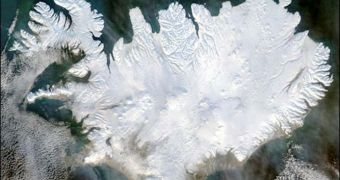In the middle of the northern parts of the Atlantic Ocean lies the small island nation of Iceland. It is located at a very peculiar place, right on top of the Atlantic Ridge, which is sort of like a seam going southwards through the mid-Atlantic. What makes this ridge extremely special is that it produces new oceanic crust each day, driving the Earth's tectonic plates against each other, and sustaining the events that take place on the other side of the planet, in the Pacific Ring of Fire. The same type of processes occur in Iceland as well, and they are mostly responsible for its shape.
Recent investigations have, for example, revealed that the island is currently being shaped and bent by the same forces that created it millions of years ago. This was made obvious this Saturday, when a volcano exploded in Iceland, reminding everyone of the precarious position they inhabit. According to data supplied by the United States Geological Survey (USGS), the two plates that slide apart in the Ridge, the Eurasian and the North American ones, move away from each other at a speed of about 1 inch per year, or roughly 25 kilometers per million year.
As this happens, magma from the Earth's upper mantle – the layer right below the solid crust – climbs up to the surface, and erupts from the ocean floor as lava. It is then deposited on the two competing plates, which therefore continuously grow. In addition to this process, Iceland is also witness to other phenomena as well, including earthquakes, volcanism and hot spring activity. In fact, the nation is renowned around the world for its geysers, which provide its people with vast amounts of geothermal energy. But of all these geological processes, volcanoes are thought to have had the most significant influence on the island, beginning some 70 million years ago.
According to geologists, it would appear that a huge pocket of magma exists below Iceland. They say that magma seeping up from this layer may have begun to solidify, and that eventually it started to form the basis for the island. The 200 volcanoes the small country has are living proof that it was tectonic processes that allowed it to develop in the first place, say investigators from the San Francisco Exploratorium museum. Iceland geologists say that the volcano which erupted on Saturday, called Eyjafjallajokul, hadn't erupted in 200 years, LiveScience reports.

 14 DAY TRIAL //
14 DAY TRIAL //